Oldsmobile Cutlass (1999 year). Manual - part 15
-------------------------------------------------------------------------------------------------------------------------------------------------------------

yellow
blue
6-12
Engine Oil
If the CHECK OIL light on the instrument panel comes
on, it means you need to check your engine oil level
right away. For more information, see “Check Oil
Light” in the Index. You should check your engine oil
level regularly; this is an added reminder.
It’s a good idea to check your engine oil every time you
get fuel. In order to get an accurate reading, the oil must
be warm and the vehicle must be on level ground.
The engine oil dipstick is
yellow and located on the
front of the engine.
Turn off the engine and give the oil several minutes to
drain back into the oil pan. If you don’t, the oil dipstick
might not show the actual level.